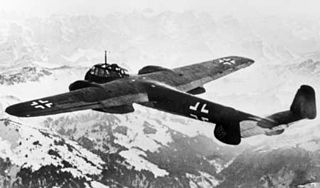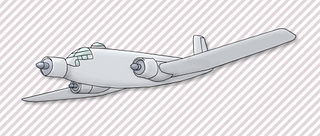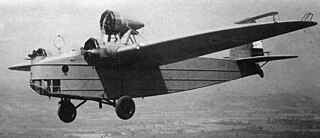| Do 23 | |
|---|---|
 | |
| Role | Bomber |
| Manufacturer | Dornier-Werke GmbH |
| First flight | 1934 |
| Primary user | Luftwaffe |
| Number built | 282 |
The Dornier Do 23 was a German medium bomber of the 1930s.
| Do 23 | |
|---|---|
 | |
| Role | Bomber |
| Manufacturer | Dornier-Werke GmbH |
| First flight | 1934 |
| Primary user | Luftwaffe |
| Number built | 282 |
The Dornier Do 23 was a German medium bomber of the 1930s.
The earlier Do 11 had exhibited several problems, so two initiatives were launched to address those shortcomings. The first resulted in the Do 13. The second effort was a more extensive rework which resulted in the Do 23. With additional landing flaps at the rear of the wings several of the handling problems were corrected, but crew and military equipment were analogous to the Do 11 and performance was still considered mediocre.
Between 1934 and 1935 282 Dornier Do 23s were built for the Luftwaffe of which 273 were assigned to the units. In 1936 the machines were replaced by the first versions of the Do 17 and were transferred to the training duties. During the war, some Do 23s were used as minesweepers, known as Minensuch — literally, "mine-search" aircraft in German — and fitted with a current-carrying degaussing ring under the airframe to create a magnetic field that triggered submerged naval mines. These aircraft were usually given an -"MS" suffix to designate them, as had been done with the similarly equipped Bv 138 MS or Ju 52MS aircraft.
Experiments with spraying devices to blow off chemical warfare agents were also carried out with Do 23 with some aircraft used to fight pests.
First aircraft received letters A, C, E and F which were designation of aircraft, not variants. The only production version was G.
Data fromAircraft of the Third Reich Volume one, [1] The Encyclopedia of World Aircraft [2]
General characteristics
Performance
Armament
Related development
Aircraft of comparable role, configuration, and era
Related lists

The Dornier Do 215 was a light bomber, aerial reconnaissance aircraft and later a night fighter, produced by Dornier originally for export, but in the event most served in the Luftwaffe. Like its predecessor, the Dornier Do 17, it inherited the title "The Flying Pencil" because of its slim fuselage. The successor of the Do 215 was the Do 217.

The Dornier Do 335Pfeil ("Arrow") was a Nazi Germany World War II heavy fighter built by the Dornier company. The two-seater trainer version was called Ameisenbär ("anteater"). The Pfeil's performance was much better than other twin-engine designs due to its unique push-pull configuration and the lower aerodynamic drag of the in-line alignment of the two engines. It was Nazi Germany's fastest piston-engined aircraft of World War II. The Luftwaffe was desperate to get the design into operational use, but delays in engine deliveries meant that only a handful were delivered before the war ended.

The Blohm & Voss BV 138Seedrache, but nicknamed Der Fliegende Holzschuh was a World War II German trimotor flying boat that served as the Luftwaffe's main seaborne long-range maritime patrol and naval reconnaissance aircraft.

The Messerschmitt Me 264 was a long-range strategic bomber developed during World War II for the German Luftwaffe as its main strategic bomber. The design was later selected as Messerschmitt's competitor in the Reichsluftfahrtministerium's Amerikabomber programme, for a strategic bomber capable of attacking New York City from bases in France or the Azores.

The Dornier Do 11 was a German heavy bomber, developed in secret in the early 1930s. It was originally called the Dornier F before being renamed by the Reichsluftfahrtministerium (RLM) in 1933, and was considered a heavy bomber at the time. It came into service in 1932, a continuation of a line of bomber designs from the Dornier Do P in 1930, and the Dornier Do Y in 1931. The line would continue to develop with the Dornier Do 13 and Dornier Do 23.

The Junkers Ju 89 was a heavy bomber designed for the Luftwaffe prior to World War II. Two prototypes were constructed, but the project was abandoned without the aircraft entering production. Elements of its design were incorporated into later Junkers aircraft.

The Dornier Do 18 was a development of the Do 16 flying boat. It was developed for the Luftwaffe, but Luft Hansa received five aircraft and used these for tests between the Azores and the North American continent in 1936 and on their mail route over the South Atlantic from 1937 to 1939.
The Henschel Hs 127 was a German bomber that was built as two prototypes, but cancelled without entering mass production.

The Dornier Do 19 was a German four-engine heavy bomber that first flew on 28 October 1936. Only one prototype flew, and it was converted to a transport in 1938. The other two were scrapped.

The Junkers Ju 352 Herkules was a German World War II transport aircraft that was developed from the Junkers Ju 252.

The Heinkel He 45 was a light bomber produced in Germany in the early 1930s, one of the first aircraft adopted by the newly formed Luftwaffe. Its appearance was that of a conventional biplane and included seating for pilot and gunner in tandem, open cockpits. Developed in parallel with the He 46, it appeared in 1931 as a general-purpose biplane and was employed mainly as a trainer, but was also used by the Luftwaffe for reconnaissance and light bombing duties. Production of this plane totalled 512 aircraft, including those built under licence by Gotha, Focke-Wulf, and BFW.

The Junkers Ju 252 was a German cargo aircraft that made its first flight in late October 1941. The aircraft was planned as a replacement for the Junkers Ju 52/3m in commercial airline service, but only a small number were built as cargo aircraft for the Luftwaffe.
The Dornier Do 317 was a prototype German medium bomber of World War II.

The Henschel Hs 124 was a twin-engine heavy fighter, attack aircraft and light bomber designed in Nazi Germany. After two prototypes had been built, work on the project was cancelled.

The Fieseler Fi 98 was a prototype ground-attack aircraft produced by German aircraft manufacturer Fieseler as a rival to the Henschel Hs 123.
The Dornier Do 29 was a proposed zerstörer, or heavy fighter, designed by Dornier as a competitor to the Messerschmitt Bf 110.
The Hütter Hü 211 was a German prototype long-range reconnaissance and heavy night fighter commissioned by the Reich Air Ministry in late 1944. The project stopped after an air raid destroyed the prototypes before they were finished.

The Dornier Do Y was a German bomber of the 1930s, the second bomber design by Dornier Flugzeugwerke.

The Dornier Do 29 was an experimental aircraft developed by Dornier Flugzeugwerke and the Deutsche Versuchsanstalt für Luftfahrt in the 1950s, used to test a tilting-propeller system for short takeoff and landing (STOL) aircraft. The concept was proved to be successful in flight testing; however, no further development of the system or aircraft was proceeded with, and at the conclusion of its test program the Do 29 was retired.
The Dornier Do 14 was a prototype seaplane, developed by Dornier Flugzeugwerke with backing from the Luftwaffe for experimental propulsion studies. The aircraft was similar to the Dornier Do 12. Only one Dornier Do 14 was constructed for testing, the aircraft registered as "D-AGON", after test flights during 1936, the aircraft engines were subsequently dismantled in 1937. The prototype aircraft was finally scrapped in 1939.
| Wikimedia Commons has media related to Dornier Do 23 . |